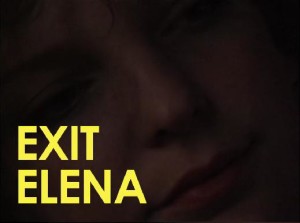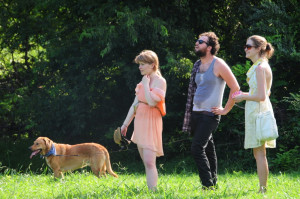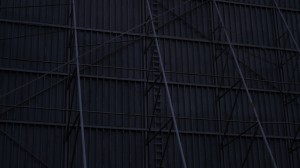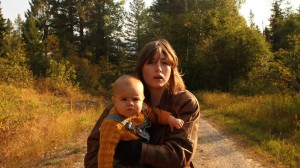While our Wisconsin Film Festival coverage is in full swing, we will continue to cover Madison’s many other film offerings. The Micro-Wave Cinema Series, run by Brandon Colvin, is perhaps one of the lesser known and more eclectic offerings. The series’ Facebook page, which provides information, reviews, and scheduling, states the mission of the series clearly: “to highlight the most adventurous, provocative, and beautiful work being made by young American independent filmmakers.”
A filmmaker himself as well as a graduate student in the UW-Madison Communication Arts Department, I sat down with Brandon to talk more about how Micro-Wave came about and what his future goals are for the series.
If we want this to work for filmmakers, then it’s the responsibility of filmmakers to make this happen.
JS: What prompted you to start the Micro-Wave Cinema Series?
BC: Simple Machine is really what has spurred and facilitated all of this. Nandan Rao is a cinematographer and director, and the site is kind of his baby, which basically came as a solution to the problem of the disappearance of discs, especially of micro-budget films.
The issue with micro-budget films is that it’s really hard to identify demand beforehand, to get your discs where people can buy them. So, filmmakers just weren’t doing it. Distributors were making less and less money on the films and were shifting their emphasis to digital distribution. After a movie has its festival run, no one ever sees it with an audience again. Filmmakers were frustrated that audiences who wanted to see their movies couldn’t get them, and they didn’t have the necessary infrastructure to market to those audiences because it’s so niche. Simple Machine is a way of trying to directly connect the filmmakers to the audience for the purpose of screenings.
JS: And you have to push it forward. It’s a great thing to have it out there as a resource, but if you aren’t going to do anything more with it…
BC: Yeah, you have to operationalize it; you have to do something with it. The problem is that the people who are most interested in this and have the resources and the audience access are either traditional programmers or filmmakers. It’s really hard to find people who are not in either of those classes who would really know how to marshal an audience and have reliable screening space, even if it’s an audience of 10 people. Programmers aren’t really incentivized to do it, because they’re already programming for festivals or for their local art-house cinema. I think the onus really falls upon filmmakers. If we want this to work for filmmakers, then it’s the responsibility of filmmakers to make this happen. I thought about this for a long time, and I didn’t really get into it because I was doing work on my own film. As soon as that slowed down, I felt like I needed to do this.
Madison is a pretty great movie town. You have UW Cinematheque and the Wisconsin Film Festival, but there’s only so much space in either of those institutions for low-budget American cinema. There’s a ton of great work out there that they just don’t have the time to program. The hardest part has been getting the word out, but interacting with the filmmakers, the logistics of getting the films, and playing them in the theater have been easy so far.
There’ve been people who have heard about Micro-Wave—especially filmmakers who are not in New York, L.A., Chicago, or Austin, where you would see these movies anyway—who say they want to start their own chapter of Micro-Wave.
JS: Do you know of other people who are doing some similar programs to yours in other locations? Also, what specifically about Madison encourages you that there is an audience for these programs?
BC: I don’t think anyone has done anything as extensive as what I’m doing. Simple Machine was designed more for one-off screenings. If you only have one-off screenings, though, you’re not going to have a stable audience, which is what I’m trying to do. There’ve been people who have heard about Micro-Wave—especially filmmakers who are not in New York, L.A., Chicago, or Austin, where you would see these movies anyway—who say they want to start their own chapter of Micro-Wave. That’s exciting because I think everyone can benefit from it. As far as Madison goes, Cinematheque is really important, as is the involvement of the University. Because of the huge institutional infrastructure of Cinematheque, the Film Festival, and the UW-Madison Communication Arts Department, there’s a ready-made audience that is both deep and wide.
JS: Your personal access to the filmmakers obviously helps influence the choices that you make and programming. What else influences the films that you pick and the order in which you schedule them?
BC: It’s really just a matter of my tastes and what I want to see. Some films I just haven’t seen and I really want to, because people I know have told me they are good. That was the case with the Nathan Silver films. Others are films that I really like that, for whatever reason, people just don’t have access to or didn’t have a strong festival life. Usually these are films that have an emphasis on form, like Zach Weintraub’s movies or Nandan’s movies. Another is Ian Clark’s film MMXIII, which treads this line between a kind of long take structural cinema with narrative elements and installation art. There’s just not much of a place for that kind of hybrid, because usually when you have Festival programming there’s experimental and there’s narrative.
To the experimental folks, the problem is that it’s a different cultural and social context—people who identify as experimental filmmakers/programmers track in a very small circle. If you are a narrative filmmaker that does experimental things, you’re not really in that circle. Conversely, if you’re also doing those things and you have narrative programmers who are looking for “strong characters” and a good storyline, if they aren’t immediately gripped by those things, they’ll turn your movie off, especially if it’s slow. They’re not really watching for form, and so these kinds of films end up getting shut out in a weird way.

I like showing these films because I don’t think that they’ve found their audience yet, but I think people like them. For example, Zach’s movies are pretty slow. He’s really interested in playing with offscreen space, subtle shifts in staging, and subtle focal shifts—things which are really important to the texture and the content of his films. And people loved them. Multiple people came up to me and said they really loved Zach’s movies.
JS: It was certainly true for me with the Nathan Silver films [Exit Elena, Soft in the Head], which were my initial exposure to the Micro-Wave films. And these are not films that I would necessarily expect to enjoy just from their descriptions. It’s one of those things where, if you give it a chance, you find far more interesting style and far richer character work that should appeal to a broad base.
BC: And, especially with Nathan’s movies, I think he’s doing great character work, but he has very specific models. These filmmakers’ precedents aesthetically are generally either European or derived from genuine American independent cinema. They don’t want to be the Coen Brothers, Spike Lee, or Tarantino. They want to be Ozu or Fassbinder. If someone tells me the plot of a Fassbinder film, it doesn’t make me want to watch it, but the fact that I know that Fassbinder is an excellent stylist and an excellent director makes me want to watch it. I think that these filmmakers need that push.
When everyone’s making films for the price of a used car, it’s hard to make sure that audiences and programmers understand that they need to ascribe intentionality to the filmmakers. Some programmers have a very clear idea of what they think successful films are supposed to be like and look like. When films don’t conform to that idea, they don’t ascribe that to intentional choice but to the filmmaker’s failure to comprehend what s/he is supposed to do.

With Nathan’s film Exit Elena, it’s not even in HD; he shot it on standard definition DV cam. People would just turn it off, because it doesn’t meet with their expectations of what a film should do. We talked to him in the Q&A session, and he said he wanted it to feel like a home movie. But it’s so difficult to have someone ever get to that conclusion if they aren’t ascribing intentionality to Nathan.
It’s important as a viewer to operate from the stance of “I’m going to assume that everything in this film was a decision the filmmaker made.” That’s not always true, but if you don’t think that way, you never come to the conclusion that Nathan is intentionally trying to muddle the distinction between documentary and fiction. And if you’re missing that, you’re missing an important thing in the film and something that bears directly on the structure of Micro-Wave: the importance of filmmaker participation and interaction.
If I show a film to you, I am saying I believe in this person as an artist, and I want you to be able to ask them about their decisions…
JS: Would you do a screening where the filmmakers could not be in attendance?
BC: No. I’m not interested in that, because anyone can do that in their home. I can make sure that the filmmakers either Skype in or come here in person. If I show a film to you, I am saying I believe in this person as an artist, and I want you to be able to ask them about their decisions and for them to answer you. Filmmakers working at this budget level are incredibly accessible and open. They don’t have agents; they don’t have people trying to protect them. A lot of them are working at this budget level out of choice, and same with me. I want the biggest budget I can get where no one can tell me what to do, ever. There’s a ceiling to that, and all these people are making this choice as artists. Plus, I think they have fun doing it.
JS: It really seemed like it from Nathan Silver’s Q&A. He was very candid and very unassuming, both of which I appreciated. Part of your role in the screenings is as a facilitator.
BC: Exactly, and it’s a two-way thing where you have to have an audience that trusts you and filmmakers that trust you. If I can be the middle man of that trust exchange, then I feel like there’s great a kind of interaction that can happen that will be beneficial for both parties.
I want there to be a certain structure, but I also want it to feel intimate in the way a concert does.
JS: For the audience, it also has a ciné-club feel. It feels like the perfect middle ground between the kind of home viewing you mentioned earlier with a big screen experience where, for all intents and purposes, the theater is rented out for us. So, it’s not necessarily disparate groups of people converging in a theater to watch a run-of-the-mill movie, but more of a club atmosphere in terms of what we all want from the theatrical experience, which generates a sense of excitement.
BC: I want there to be a certain structure, but I also want it feel intimate in the way a concert does. A musical performance is structured, but there is a really intense interaction between the audience and the performer. Going to a concert feels different than seeing a movie at the multiplex, and I would rather it feel more like a concert.
JS: Obviously the schedule is continuously evolving, which makes sense given your commitment to filmmaker presence. How long do you plan to keep running this series?
BC: Forever. I’ll keep doing it while I’m here, and I hope to pass it off to someone when I leave. On the semester level, I’m trying to stop the screenings before the end. I think a lot of our audience is comprised of students. They’re also extremely busy at that time, so it just makes sense to cut things off before the end of the semester. I’m not looking at summer screenings, because in the summer you lose some of the infrastructure and audience. It is tough when you have filmmaker interaction, because they have schedules that can change very quickly. They are often out of town screening their films, so trying to involve that component means that the schedule is going to shift at times, but I’m hoping to do more pre-planning during the summer.
Comparisons foster questions.
JS: What has been your thought process behind scheduling double features?
BC: One of my goals has been to provide unique programming. I don’t know that I’ll do double features in the future, but for this first semester it was important to me. I’m trying to do a kind of sneaky auteurism here. A lot of these filmmakers have made features that are relatively short, and I think there’s something productive in seeing two films by a young developing filmmaker back-to-back. You see consistencies, you see changes, and I think it’s productive in terms of how the Q&A’s work. Comparisons foster questions, so when you can compare the two films, you have questions that you would never have asked if you only saw one of them.
The films also refract into each other, so they’ll illuminate each other when you put them together. I want people to get a sense that these filmmakers have a personal imprint on their work. When we did Kentucker Audley’s Open Five and Open Five 2, it was the first time those films have ever been publicly shown back-to-back. Instead of having double features in the future, since the reservoir (for now) is running low for these kind of paired screenings, my plan is to actually have single-film nights but show them more frequently. Right now there’s usually a two- or three-week gap between screenings, but I’d like to have them more frequently in the fall, keeping them on Sunday evenings to work around Cinematheque.
JS: You’ve mentioned your several different goals for the project and how you see it evolving over time. Ultimately, what does success look like to you for this series?
BC: That there is someone at every screening who has their mind open to something new. The series comes at very little cost to me or to anyone, so any benefit is a profit. I think these movies are important, and I think they’re marginalized for whatever reason. If people like the movies and become aware of these filmmakers, that’s really all I care about. The Facebook page is the main source of information about the series. If you like the Facebook page, I would encourage you to come to the screenings. Everyone would be very appreciative, and it’s much more fun when more people come.
And there are certainly some exciting movies on the way. Here’s a list of the upcoming Micro-Wave screenings, along with Brandon’s thoughts on each:
March 16
The Men of Dodge City (Nandan Rao, 2012, 93 min)
The Other Men of Dodge City (Nandan Rao, 2014, 77 min)
BC: Nandan was approached by documentary filmmakers Andrea Sisson and Pete Ohs. They saw his film and asked if they could recut it, and so Nandan gave them all 60 hours of footage, all his editing notes, and all the project files for all the iterations of his cuts. They completely recut the movie, used alternate takes, reordered scenes, and added music that isn’t in the original version. I won’t say for sure, but I think this might be one of the first times that a film will been screened in its original version and then been screened in a completely recut version from the original footage. Not just the director’s cut, where you have added footage that was in the original timeline, but completely new editorial decisions being made. I think that’s fascinating and will be a really instructive lesson that otherwise you would never experience.
March 30
MMXIII (Ian Clark, 2013, 67 min)
BC: Ian also works as an installation artist, and I think Clark’s film is a complete masterpiece. It just blew me away, and it has some of the most beautiful shots I’ve seen in American films in the past few years.
April 13
It Was Great but I Was Ready to Come Home (Kris Swanberg, 2009, 61 min)
Empire Builder (Kris Swanberg, 2012, 72 min)
BC: She’s also going to bring her new short film, so we might be the first people to see it after SxSW. It will also be really exciting to talk to her because, even before she knew her husband (filmmaker Joe Swanberg), she was a filmmaker herself. Her career was on hiatus while she had her first child. I think it’s a really good moment to be able to talk to a female filmmaker about what it’s like to be a female filmmaker, and especially a female filmmaker who has a family and what it’s like when you have two filmmakers in the family. Another one of my goals going forward is to try to get as many women filmmakers as possible to be involved.
For my part, I can say that I have found great benefit from the series already. It has made me take a closer look at a type of filmmaking that, in the past, I confess to dismissing unfairly and, in the process, deny myself films that engage my intellect to discover what lies at the center of their more ambiguous or oblique narrative styles. This weekend’s Dodge City films are prime examples. I would encourage you to like the Facebook page and, if you are at all curious, give one of these screenings a try.



